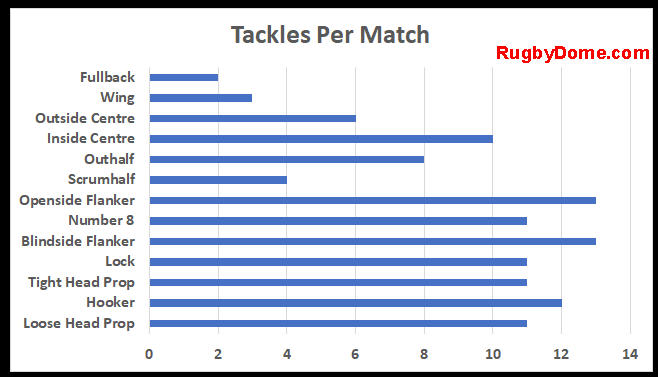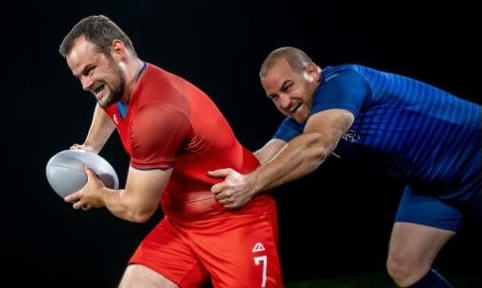We looked at the statistics for tackles during the 2021 Six Nations Rugby Championship.
This article uses these figures to calculate how many tackles are made by players in a rugby match.
You may be surprised to see that there are huge differences between player positions.
How Many Tackles Do Rugby Players Make?
This graph shows the breakdown of tackles by rugby position based on statistics from the 2021 Six Nations tournament.

And here is the raw data (with some extra info about minutes between tackles):
| Position | Estimated Minutes Between Tackles | Estimated Tackles Per Match |
| Loose Head Prop | 7.3 | 11 |
| Hooker | 6.9 | 12 |
| Tight Head Prop | 7.2 | 11 |
| Lock | 7.1 | 11 |
| Blindside Flanker | 6.4 | 13 |
| Number 8 | 7.3 | 11 |
| Openside Flanker | 6.0 | 13 |
| Scrumhalf | 19.1 | 4 |
| Outhalf | 10.3 | 8 |
| IC | 7.8 | 10 |
| OC | 12.8 | 6 |
| Wing | 23.0 | 3 |
| FB | 39.4 | 2 |
Which Rugby Position Tackles The Most?
Flankers are the top tacklers in rugby matches. They average thirteen tackles per game.
There was very little difference between blindside and openside flankers. Openside flankers make a fraction more than their blindside teammates.
When you watch matches on television, the studios often show some statistics at half time and full time. These include the top tacklers.
You may notice much higher numbers than the averages we’ve given.
This happens when one team has more possession than the other. A team under defensive pressure throughout a match makes more tackles.
Record number of tackles
In 2018, an openside flanker set records in an elite club match by making 34 tackles.
That was Leinster’s Josh van der Flier. He racked up these numbers in a derby match between Leinster and Connacht in 2018. This was a record for the PRO14 tournament and also for his club.
What’s even more impressive is that the young flanker didn’t miss a single tackle!
And what about international matches? In the 2011 Rugby World Cup, the Welsh captain averaged 20 tackles in every match he played.
That was Sam Warburton, who was also an openside flanker. He’s also on our list of the greatest flankers of all time.
Decades ago, when defense wasn’t so organized, we were amazed when players hit double digits. That was considered exceptional. But hitting twenty tackles is very unusual.
Which Rugby Position Makes The Least Tackles?
In the 2021 Six Nations tournament, fullbacks averaged only two tackles in a game. That’s about one in each half!
Wingers didn’t make much more. They made about three tackles per game.
We have an article on which position in rugby is the easiest. It’s a little tongue-in-cheek, but we also want to help people who are thinking of joining a club session to try the sport.
One of the reasons we decided on winger, is for the low number of tackles required in the position.
Forwards Tackle More Than Twice As Much As Backs

This probably isn’t big news to you. But we’ve got the numbers to back up the assertion.
Every forward makes on average at least eleven tackles per match.
The closest in the backline is the inside centre, with an impressive ten tackles. Interestingly, the flyhalf is the next highest back with eight tackles.
Some teams or countries hide the tens in defence by having them drop back. This isn’t so common in the Six Nations. Try to stop Owen Farrell or Jonathan Sexton from making tackles!
Scrumhalves only make four tackles?
You may be surprised that the scrumhalf only makes four tackles, given they are so close to rucks. The reason is that in modern defenses, the scrumhalf takes the role of sweeper.
They drop back in order to catch breaks through the defensive line. This means that those four tackles are often the most important try-savers in the game.
Which Centre Makes More Tackles?

People sometimes say that there’s very little difference in the modern game between inside and outside centre.
Why not just stick the two biggest centers onto the pitch and beast the opposition? Alternatively, pick two fleet-footed but slight centres and run riot?
Well, our breakdown of tackle numbers points to one reason that coaches make their selections.
Inside centres make an average of four more tackles per match than outside centres. Specifically, the twelve shirt averaged ten tackles while the thirteen shirt made six.
This makes sense when you consider that the 12 stands closer to the set piece. If the 13 is in luck, his teammate has already tackled a ball carrier to the ground before the 13 has to get involved!
How We Calculated These Numbers

We downloaded match statistics for 2021 from the official Six Nations website. This covers every match across five rounds.
The statistics give the number of tackles made across the tournament by every player. They also give the number of minutes played across the tournament.
Eliminating outliers
We spotted some eye-catching outliers in the stats. For example, Welsh prop Nicky Smith got three minutes of game time in the tournament.
But because he made three tackles, we could say he made three tackles per game or extrapolate it out to 80 tackles over a hypothetical 80 minutes.
Before we made our calculations, we eliminated any player who played less than 80 minutes across the tournament.
Our calculated numbers
The Six Nations statistics were across the entire tournament, not a single game.
So we divided the total number of minutes played by the number of tackles made. This gave us a measure of how often a player makes a tackle i.e “Estimated Minutes Between Tackles”.
Then we took 80 minutes as the length of a match and divided this by our estimated minutes between tackles. That gave us our “Estimated Tackles Per Match”.
Of course, this isn’t a perfect way of calculating these figures. But it’s good enough to work with. The actual numbers aren’t what interests us. We’re more interested in how the positions differ.
Why we didn’t split the second row into separate numbers
Although we separated blindside and openside flankers, we didn’t split locks and wingers into separate positions.
The different lock positions (4 and 5) can be specialists. A heavier lock may play at 4 and pack down behind the tight-head prop in the scrum.
But I didn’t see any point in splitting 4 and 5 for tackling.
Why we didn’t split the wingers into separate numbers
I was tempted to split the wingers into left and right i.e. 11 and 14. This is because I suspect that there is a slight difference.
Traditionally teams passed better from right to left (most players being right-handed), which meant that coaches put the best tackling winger out on the right. But now, the position tends to be based on which foot a winger kicks best with.
So, does the right wing still make more tackles in the modern game?
Well, when I looked at the Six Nations stats, I realized that the same individuals were swapping wings from match to match. Particularly the French!
As the tackling numbers are reported by individual and not positions, I figured it was too much work to figure out who was playing where. Especially when the average was a paltry 3 across both positions.